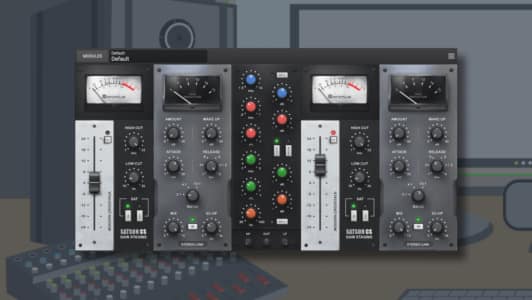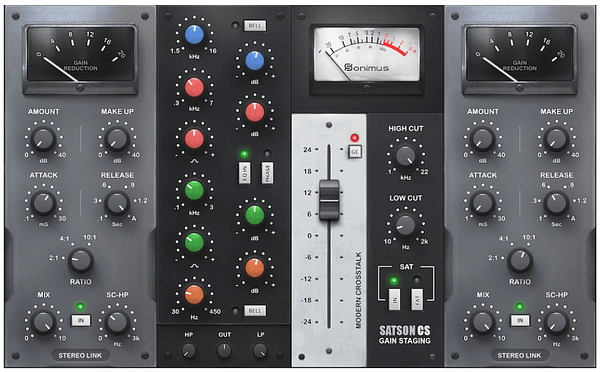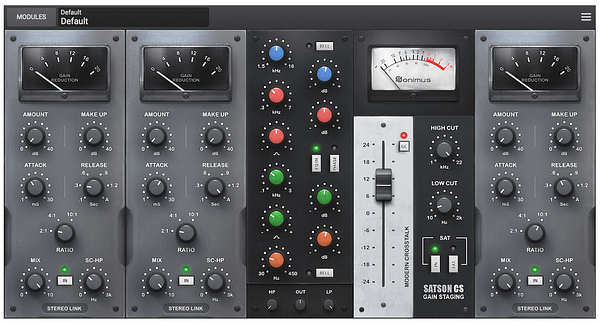Satson CS is an excellent asset for content creators and producers who must finish their music quickly with the highest quality possible. Adding sequential modules of EQ, compression, and saturation in one place provides everything needed to achieve the best sound for your music and audio processing.
However, it is especially helpful when using a top-down mixing approach, as we want to process our master mix bus efficiently and effectively. On top of that, we will be adding the sound and character of a classic solid-state 4000 console right in your DAW.
Keep reading and learn how to apply each module to get a polished and engaging sound for your mixes using Satson CS in your master bus.
What’s your chain?
Regardless of the number of plugins in your master chain, Satson CS is designed to optimise your workflow. It efficiently saves processing power without compromising audio quality, making it a valuable tool for content creators and producers.
A regular master bus chain looking for a release-ready product will include compression, EQ, clipping and limiting. Following that same chain, our Satson CS configuration would look something like this:
If you want to swap modules around and experiment, you can rearrange the chain in any way you like without losing each module’s configuration.
Some engineers like to use two compressors in series or a dual compressor to attack different mix characteristics and maximise the loudness without losing dynamic. Satson CS allows us to rearrange and add more modules to our chain, adding an extra compressor module at any point and configuring it to complement our previous compressor.
Compression
In our previous article, we covered two different strategies for master bus compression. Thanks to Satson CS modularity, you can apply both to your chain and choose between them by bypassing one. However, you can also apply different compression settings in series, just like other dual compressors in the market. Keeping the same philosophy explained in the master bus article; you can use the 2:1 ratio for both compressors but change their attacks, releases and drives to obtain different attitudes from each. Using a medium-fast attack and fast release in the first compressor will catch more of the transients and peaks from the track, while a slow attack and auto-release will affect the average sound of the mix. The aim is to read no more than 2 dB of gain reduction per compression.
EQ
Due to its complexity, equalising the whole track should be done with subtle moves. The fully parametric EQ module from Satson CS allows us to tackle the overall tone of our track with precision. It’s common to pay attention to the low and high end of your track to ensure the bass is solid but not overwhelming while the track is bright enough but not harsh. Also, a subtle filtering around 25 Hz can help you remove any remaining rumble from your track. The smiley face technique is usually beneficial to make your track louder. However, don’t hesitate to clean or tame any frequency that might be causing issues in your mix.
Listening to reference tracks or artists and comparing them with your music will help you notice any difference In tone.
Clipping
While Stason CS does not have a clipping module, the gain compensation feature in the preamp module allows you to achieve the soft clipping effect right in the plugin. Press the gain compensation button next to the fader and increase the fader’s level until you reach the desired saturation.
Limiting
Finally, one last compressor module with extreme settings will help you reduce the dynamics of your track and increase the overall volume. The fastest attack possible and a 10:1 ratio should help you achieve this effect. Then, set the release time so it recovers at the song’s rhythm and set the amount and make-up gain accordingly.
Console Feeling
For an extra console flavour, we recommend adding a preamp module at the beginning of the chain to emulate sending your mix through a 4000 mixing console channel. This will add glue and analogue harmonics, enriching the sound of your mix.
If, at any point of the chain, you need extra control of the gain structure, you can add preamp modules with the saturation off so you can use the fader as a simple volume knob.
Now, the only thing left is to save your chain as a preset for quick recall ability and add it to your production or mixing template.
Do you use Satson CS in your master chain? What does your chain look like? Did you know any of these recommendations? Let us know in the comments, and subscribe to our newsletter for the latest news about Sonimus products.











Leave A Comment
You must be logged in to post a comment.